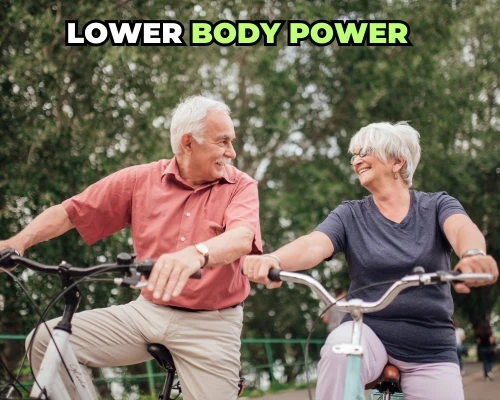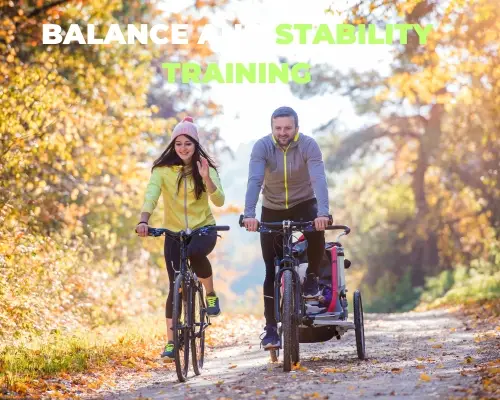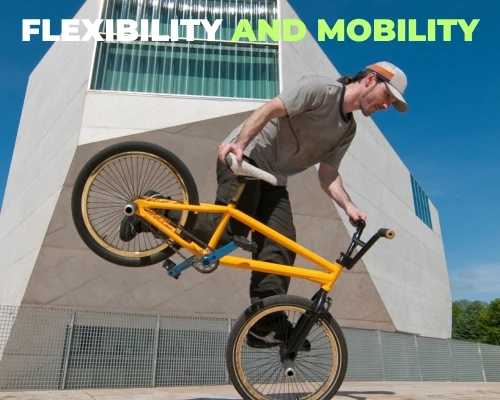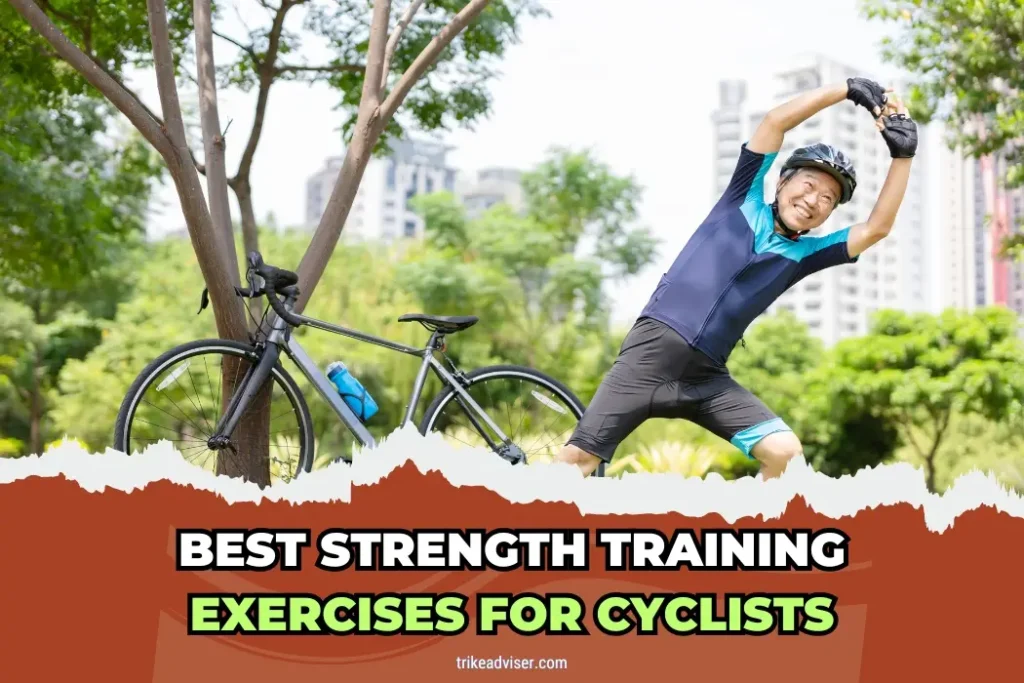Best Strength Training Exercises for Cyclists?
Many cyclists believe that long rides alone will prepare their muscles for all challenges. This isn’t true. Focused strength training can drastically improve endurance and power on the bike. It also prevents injuries that long rides often bring.
How does one add strength training without sacrificing pedal time?
Consider this: Are your legs giving out during long climbs? Does your lower back scream after an hour? These are signs you need strength training.
Strength exercises are not just for show. They build the core and leg strength essential for effective pedaling. If your rides feel harder than they should, maybe it’s time to hit the gym.
Start with targeted exercises to boost your cycling performance. Trust me, your bike will thank you.
Best Strength Training Exercises for Cyclists
Dumbbell Deadlifts
For cyclists, the lower back, hamstrings, and glutes are critical. Dumbbell deadlifts target these areas effectively. Stand with feet hip-width apart, weights in hand. Hinge at the hips, lower the weights, then lift, engaging your core. This exercise builds power for pedaling and climbing.
Renegade Rows
Core and upper back strength are essential for cycling posture. Begin in a high plank with dumbbells. Keep hips stable, pull one weight towards your ribcage, then switch. This movement enhances balance and endurance on long rides.
Kettlebell Swings
A dynamic exercise for the glutes, hamstrings, and core. Start with the kettlebell low, swing through your legs, then up to shoulder height. This explosive movement increases your power during sprints.
Single Leg Deadlifts
Balance and unilateral strength are key for cyclists. With a dumbbell in each hand, lift one leg. Hinge at the hips, lower the weights, then rise. It mimics the pedaling action, enhancing muscle coordination.
Front Squats
Focus on quads, glutes, and core. With weights at your shoulders, squat while keeping your chest up and core tight. This builds the lower body strength necessary for effective pedaling.
Squats
The classic squat strengthens quads, glutes, and core. Stand with feet apart, lower into a squat, then rise. It’s fundamental for lower body strength, crucial for every cyclist.
Deadlifts
Targeting the lower back, hamstrings, and glutes. Stand with weights at your feet. Lift with a flat back, focusing on the posterior chain. Essential for strong, injury-free cycling.
Bench Press
Strengthen the chest, shoulders, and triceps. Lie on a bench, press weights from chest up, then lower. This builds upper body strength for better bike control.
Military Press
Enhance shoulder and triceps strength. From standing, press weights overhead, then lower. It improves upper body endurance, important for long rides.
Barbell Row
Target the upper back and biceps. Lift a barbell to your chest, keeping elbows in. This strengthens the back for better cycling posture.
Additional Tips: Prioritize form to avoid injuries. Start with manageable weights, and progress gradually. For cyclists, single-leg exercises are beneficial as they closely simulate the pedaling action. Include low-volume, high-recovery workouts to build strength without overtraining.
Cycling-Specific Drills: Incorporate cycling-specific exercises like calf raises, quad extensions, and hamstring curls. Use resistance bands for squats to simulate cycling posture. This targeted approach ensures the muscles most used while cycling are strengthened.
Lower Body Power

Strengthening the lower body is crucial for cyclists. It boosts power, speed, and endurance. Let’s dive into the best exercises: squats, deadlifts, and leg press variations.
Squats
Why Squats?
Squats enhance balance and strengthen the hamstrings. They condition the muscles differently than cycling.
How to Perform:
- Stand with feet wider than shoulders.
- Lower your body as if sitting in a chair. Keep your back straight.
- Stand back up.
- Perform 10-20 reps or hold for 30-60 seconds per leg.
- Complete 2-3 sets with short breaks between.
Tips:
- Keep your weight on your heels.
- Ensure your knees don’t go past your toes.
Deadlifts
Why Deadlifts?
They target the hamstrings, glutes, and lower back. Essential for powerful pedaling.
How to Perform:
- Place a barbell or dumbbells at your feet.
- Bend and lift the weights, engaging your lower back and hamstrings.
- Lower them back to the ground.
- Aim for 8-12 reps, three sets.
Tips:
- Keep the back flat during the lift.
- Focus on a smooth, controlled movement.
Leg Press Variations
Why Leg Press?
This machine focuses on quadriceps, hamstrings, and glutes. It builds overall leg strength.
Variations:
- Standard Leg Press: Sit in the machine, place feet on the platform, and press.
- Romanian Deadlifts: Stand, lower weights in front of you, lift focusing on hamstrings and glutes.
How to Perform Standard Leg Press:
- Adjust the seat so knees are bent but not strained.
- Press against the platform, extend legs, then return slowly.
- Perform 10-15 reps, three sets.
Tips for Romanian Deadlifts:
- Keep legs slightly bent.
- Lower the weights by bending at the hips.
- Lift by extending your hips, not your back.
Balance and Stability Training

Improving balance and stability is crucial for any cyclist, especially those tackling mountain trails or seeking smoother handling. Here’s how to build these skills effectively.
Exercises to Improve Balance and Bike Handling
1. Just Balance
- Objective: Stand on a balance board or BOSU ball to maintain stability.
- Progressions: Transition to a split stance, hold a weighted bar, or integrate squats.
2. Rock Back and Forth
- Objective: With one foot ahead of the other, rock the board backward and forward.
- Progressions: Use a larger board, simulate handlebar holding, or squat while rocking.
3. Tilt Side to Side
- Objective: Balance with feet parallel and tilt the board side to side.
- Progressions: Hold a weighted bar like handlebars, choose an unstable surface, or squat during the tilt.
4. Single-Leg Glute Bridge
- Objective: Perform a glute bridge on one leg, mimicking the pedaling motion.
- Progressions: Introduce more instability or use a bar to represent handlebars.
5. Lateral Lunge to Single-Leg Balance
- Objective: From beside a BOSU ball, perform a lateral lunge then balance on one leg.
- Progressions: Vary the height or stability of the surface for increased difficulty.
6. Single-Leg Deadlift
- Objective: Hinge at the hips on one leg, maintaining a straight back and engaged core.
- Progressions: Add a weight or perform on an unstable surface.
These exercises challenge the body to manage different motions while keeping the legs and upper body coordinated, directly enhancing cycling performance.
Incorporating Yoga and Pilates into Cyclist Training
Yoga and Pilates are not just supplemental; they are pivotal in developing the core and pelvic stability needed for effective bike handling.
Yoga Movements:
- Tree Pose: Stand on one leg with the other foot on the inner thigh. For more challenge, close your eyes or use an unstable surface.
- Plank with Leg Lift: In a plank, lift one leg, maintaining alignment. Progress by lifting higher or extending the hold.
Pilates Exercises:
- Single-Leg Squat: Stand on one leg, squat while keeping balance. Increase difficulty by holding a weight or using an unstable surface.
- Side Plank with Leg Lift: Hold a side plank, lift the top leg, and keep aligned. Challenge yourself by lifting higher or holding longer.
Benefits and Tips:
- Both disciplines strengthen core muscles, essential for stabilizing movements on the bike.
- Focus on controlled, precise movements to maximize benefits.
Flexibility and Mobility

Stretching: Before or After Cycling?
Sounds easy, right? When to stretch might seem like a small detail. It’s not. Stretching before cycling should involve dynamic movements. Think leg swings or gentle torso twists. These prepare the muscles without reducing strength.
After your ride? That’s the time for static stretches. Hold each stretch to cool down the muscles. This reduces soreness and improves flexibility.
Key Stretches and Mobility Exercises for Cyclists
Figure 4 Stretch
- Focus: Hits the glutes and hips, easing lower back tension.
- How-To: Sit on the floor, one leg crossed over the other, lean forward gently.
Primal Squat Stretch
- Focus: Opens up the glutes, hamstrings, and hips.
- How-To: Drop into a deep squat. Hold this position, pushing knees out with your elbows.
Standing Hamstring Stretch
- Focus: Lengthens the hamstrings, crucial for pedal power.
- How-To: Bend forward at the waist, legs straight, reach toward your toes.
Hip Flexor Stretch
- Focus: Targets the hip flexors, key for pedaling comfort.
- How-To: Step one foot forward, drop into a lunge, push your hips down.
Glute Bridge
- Focus: Strengthens the glutes for better ride stability.
- How-To: Lie on your back, feet flat, lift your hips high.
Leg Swings
- Focus: Enhances hip mobility, important for fluid pedaling.
- How-To: Stand and swing one leg forward and back, then side to side.
Spiderman Lunge with Twist
- Focus: Boosts hip and core strength.
- How-To: Step forward into a lunge, place hands on the ground, rotate your torso and reach upward.
Resistance Training Techniques
Proper resistance training can significantly enhance your cycling performance. Here’s how to use resistance bands and weights effectively and increase resistance safely.
Understanding the Role of Resistance Bands and Weights
Resistance Bands:
These tools offer variable resistance, which means the tension increases as the band stretches. They help improve endurance, flexibility, and strength. They’re light, portable, and perfect for a range of exercises. Use them anywhere — at home or on the go.
Weights:
Free weights like dumbbells and barbells provide constant resistance. This helps in progressive muscle overload and growth. They’re key for boosting muscle power and size. Machines help target specific muscle groups more precisely, ideal for focused strength gains.
Both tools are crucial for a balanced workout regime. They target different muscle aspects, ensuring overall muscle health and growth.
How to Safely Increase Resistance in Training
Progressive Overload:
Start slow, then gradually up your game. Add more weight, increase reps, or boost exercise intensity. This method ensures continuous improvement without overwhelming your muscles.
Proper Form:
Always focus on maintaining correct form. This is crucial for muscle engagement and injury prevention. Controlled movements, aligned breathing, and correct posture maximize training benefits.
Listen to Your Body:
Heed your body’s signals. Pain, discomfort, or fatigue are warnings. Adjust the resistance if needed. It’s vital to push limits safely and avoid potential harm.
Rest and Recovery:
Muscles need downtime to repair and grow stronger. Skipping rest can lead to injuries and stall your progress. Include rest days in your training schedule for optimal recovery.
As an Amazon Associate, I earn from qualifying purchases, at no additional cost to you. Read Our Affiliate Disclosure.

